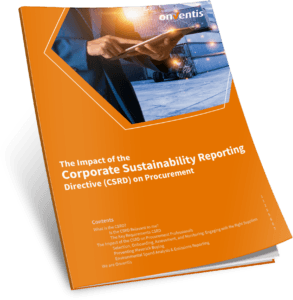What is the Corporate Sustainability Reporting Directive (CSRD)?
In December 2019, the European Green Deal was launched. This Green Deal comprises a package of policy initiatives aimed at making Europe the world’s first ‘climate-neutral continent’ by 2050. The CSRD (Corporate Sustainability Reporting Directive) is a key component of the Green Deal, designed to enhance transparency and improve the quality of sustainability information from organizations. The CSRD is a European directive, meaning it must be transposed into national law in the member states. The deadline for this is July 2024.
Whitepaper: The impact of the CSRD on Procurement

The CSRD timeline
When do you need to take action with the CSRD? The bottom line: eventually, every company will have to address it. In the coming years, there will be an increasing emphasis on sustainability and the need to report on sustainability activities for businesses. The CSRD will become relevant for everyone. However, there is a timeline, outlined as follows:
Starting from January 1, 2024, it becomes mandatory for all large public interest entities (such as listed companies, insurers, banks) to include sustainability in their annual reports.
From January 1, 2025, mandatory CSRD reporting begins for all large entities. A company is considered large if it meets at least two of the three criteria below:
– Employs more than 250 staff members
– Generates an annual turnover exceeding 40 million euros
– Has a balance sheet total exceeding 20 million euros.
Starting from 2026, CSRD reporting becomes mandatory for all listed SMEs (Medium-sized Enterprises).
But why does the CSRD become relevant for everyone? This is because the CSRD covers the entire supply chain. So, whether you are a large enterprise or not, if your customer or supplier needs to comply with the CSRD, so do you. This makes the CSRD highly relevant legislation for procurement and supply chain professionals.
The CSRD key requirements
The main requirements of the CSRD are:
- Comprehensive Reporting Obligation: The CSRD has an extensive scope of reporting obligations with a total of 82 reporting requirements.
- Detailed Sustainability Information: Companies must report on various sustainability topics, ranging from environmental issues to anti-corruption measures. Additionally, they are required to report on three emission scopes: 1) Direct Emissions, 2) Indirect Emissions, and 3) Other Indirect Emissions. These emissions are also defined in the Greenhouse Gas Protocol (GHG Protocol).
- Standardization and Double Materiality: The CSRD mandates the standardization of sustainability information. Furthermore, companies must conduct a double materiality assessment, both inside-out and outside-in.
- Mandatory Assurance: Companies are required to have their sustainability information audited by external accountants to ensure reliability and credibility.
- Digital Reporting and Timelines: Companies are obligated to publish sustainability information as part of their annual reports and must do so within a specified timeframe.
Stay tuned for more CSRD information
Take the next step towards CSRD-compliance with Onventis. Gain more knowledge of the impact of the CSRD on procurement and supply chain by following us on LinkedIn or subscribe to our newsletter.
Weitere BlogsMore BlogsMeer blogs



